EXCERPTS FROM AN ARTICLE I POSTED IN SEPTEMBER OF 2016:
90 Year-Old Horticulturist Takes Care of a Five-Acre Jujube Orchard with 300 Trees
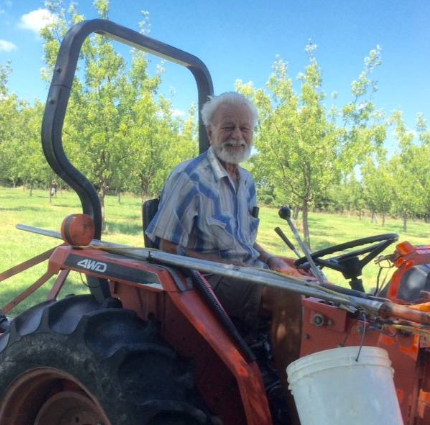
Chris Jacobsen on his tractor with his orchard of 300 jujube trees in the background – September 3, 2016
[Note: I think Chris has since passed on, but no certain.]
FROM 2O16:
This past weekend I followed my own advice and visited Chris Jacobsen’s Jujube Etc. Farm. As I mentioned in a previous article, you can visit Mr. Jacobsen’s farm during September weekends: 10 to 5 on Saturdays and 2 to 6 on Sundays. His 35-year old jujube orchard covers about five acres and contains 300 jujube trees. The exact location of his 15-acre farm is 7904 County Road 572 in Farmersville, Texas 75442. Chris, a remarkable man, manages this farm all by himself. If you wish to visit other than on a Saturday and Sunday in September, please call him at 972-784-6480.
Chris began his long life in Denmark. Like his father before him, Chris was educated as a horticulturist. His father built one of the largest greenhouses in the southern area of Denmark. It survived World War II—the teenage years of young Chris. In the early ‘50’s when he was 26, Chris spent a year traveling all around the world—from the USA to Australia. He ended up settling in the USA and going to work as a salesman for Stark Brothers Nurseries and Orchard Company. [Founded in 1816, Stark Brothers is one of the oldest nurseries in the USA.] As it turned out Chris was assigned a sales territory in Texas. I believe he settled in the Irving area and then in 1974 he bought his present homestead in the Farmersville area and settled there. Since that time he has been very busy growing his beautiful jujube orchard.
The orchard is beautiful. Its symmetry is a testimony to the professionalism of Chris Jacobsen who has planted, grafted, and tended each of these 300 trees for over 35 years.
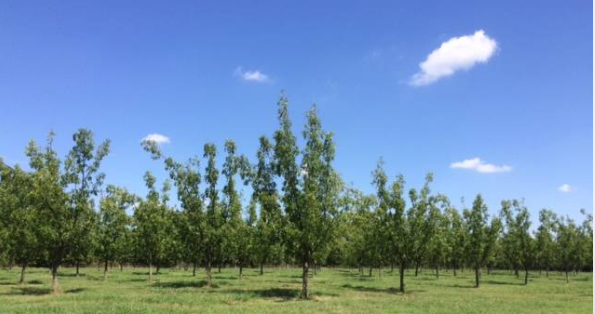
A few of the 300 trees in Chris Jacobsen’s Jujube Orchard – September 3, 2016. Begun over 35 years ago, neither chemical sprays nor chemical fertilizers have been used in this orchard. As far as we know, this is the only commercial jujube orchard in the USA.
_______________________________________________________________
Will Chris Jacobsen’s Work Carry on?
I certainly hope so. Its fate seems to be largely in the hands of a fellow named Bryan Gordon. Bryan met Mr. Jacobsen several months ago through a fellow permaculturist and good friend of Chris Jacobsen. Bryan is a horticulturist, permaculturist, and arborist.
Over the last several months, Bryan has built a working relationship with Mr. Jacobsen. He volunteers when he can to assist Mr. Jacobsen in keeping his place in working order. In return Mr. Jacobsen is teaching Bryan how to carry on his dream of sharing jujubes and their healthy benefits with the world. In addition to learning how to graft the trees and take care of them, he is also learning how to make the Jujube products Mr. Jacobsen once sold such as soap, skin care products, capsules and more. Bryan hopes to incorporate a jujube orchard into his future farm plans and keep Chris' legacy going.
As far as the future of the farm, Mr. Jacobsen has donated the property to a Christian organization.
____________________________________________________________________
Landon Winery Purchases Some of the Jacobsen Jujubes
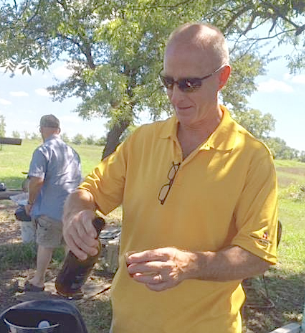
Bob Landon served up samples of Landon Winery sherry made from Jacobsen Jujubes. Sherry from Jacobsen jujubes is delicious! You can only find it at Landon Winery.
As an added treat on Saturday, Bob Landon of Landon Winery was at the farm on Saturday. Landon Winery has two locations: 101 North Kentucky Street in downtown McKinney and also a downtown location in Greenville, Texas at 2500 Lee Street. Bob was giving out free samples of the sherry from the winery that was made with Jujubes from Mr. Jacobsen’s trees. It was delicious. Charlie bought a bottle for me. It was quite a bargain. I don’t know if Bob will be there again or not but it’s worth the drive out there to see. If he is not there, you can always visit the Landon Winery in McKinney or Greenville.
We hope that a local grocery store will soon be featuring this delicious and international award-winning treat. How special! Local sherry produced from a local orchard—possibly the only commercial jujube orchard in the USA. This sherry, a connoisseur’s choice, recently won the Lone Star International gold medal for excellence.
This sherry recently won a gold medal in the Lone Star International Wine Competition.
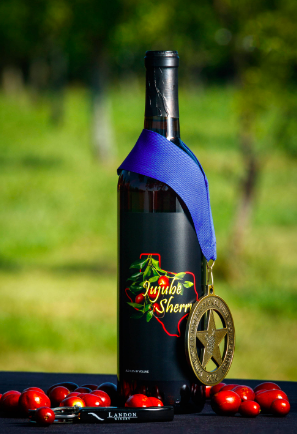 photo courtesy Jesse Patterson Photography
photo courtesy Jesse Patterson Photography
________________________________________________________________

Kari and Jesse Patterson also came to pick jujubes today. Mr. Jacobsen has some loyal followers and jujube fans! This is Kari and Jesse’s third year to visit the farm.
Jesse, a professional photographer, has taken some great photos of Mr. Jacobsen on his tractor and around the orchard.
See more of Jesse’s work at JessePattersonPhotography.com
________________________________________________________________
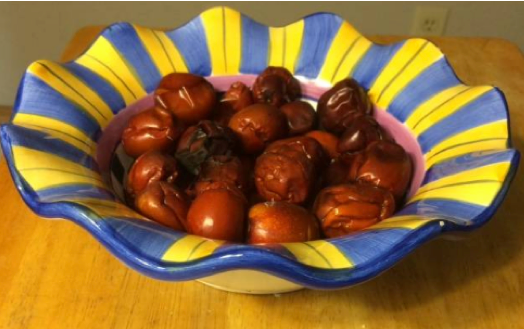
Bowl of Jujubes hand-picked by Charlie from the Jacobsen Orchard– September 3, 2016
So, what’s all the fuss about jujubes?
The Jujube (Ziziphus jujuba) is a remarkable fruit. I would elevate it to the position of a super food such as kale. It can be grown from Pennsylvania to Mexico. It prefers hot and dry climates while it will tolerate temperatures a few degrees below zero. While it’s a good choice for our Garland Community Garden (and we do have a small one growing there); it’s not an outstanding choice for most urban yards—unless you happen to be a dedicated gardener.
Jujubes Contain Betulinic Acid
Betulinic Acid has been found to selectively kill human melanoma cells while leaving healthy cells alive. Due to its apparent specificity for melanoma cells, betulinic acid seems to be a more promising anti-cancer substance than drugs like Taxoi because Taxoi is a general cell poison and is not specific to cancer cells. Also, betulinic acid has antibacterial properties and inhibits the growth of both Staphylococcus aureus and Escherichia coli. Sources:
http://www.sciencedirect.com/science/article/pii/S0304383501007182
http://www.eurekaselect.com/69339 - http://onlinelibrary.wiley.com/doi/10.1002/med.10053/full
Jujubes are packed with potassium and magnesium
Potassium is a proven heart strengthener while magnesium works in conjunction with potassium. Jujubes increase the level of the body’s nitric oxide, restoring and dilating the blood vessels for better blood circulation.
And there is so much more to know regarding the healthy benefits of the jujube. Just Google jujube and look at all the information that appears—from medical articles, to health products, to recipes. I simply steep a bunch of jujubes in boiling hot water, strain off most of the pulp and drink the delicious and healthy tea. The leaves of the jujube also can be used to make tea as well.
HAPPY JUJUBE TO YOU!
____________________________________________________________________
More Information for You